Minnesota - The North Star State - has been billed on the state's license plates as "The Land Of 10,000 Lakes." I'm told that lakes actually number closer to 12,000 in Minnesota, but who's counting? Apparently someone is, but let's just say there are way more lakes than vineyards in Minnesota.
We'll keep an eye on that, though, because the Minnesota grape industry has seen huge growth in recent years. The number of vineyards in the state doubled between 2003 and 2008. Even so, the state's grape and wine industries are still young. Minnesota's wine production in 2009 was ranked the eighth lowest in America, at just over 114,000 gallons.
It gets cold in Minnesota, so winemakers there rely largely on grape varieties that are hardy enough to survive the winters. French hybrids are popular, and the state has even created its own varieties like Edelweiss and St. Croix specifically for their cold weather durability. The University of Minnesota's oenology program came up with the Frontenac and Marquette grapes.
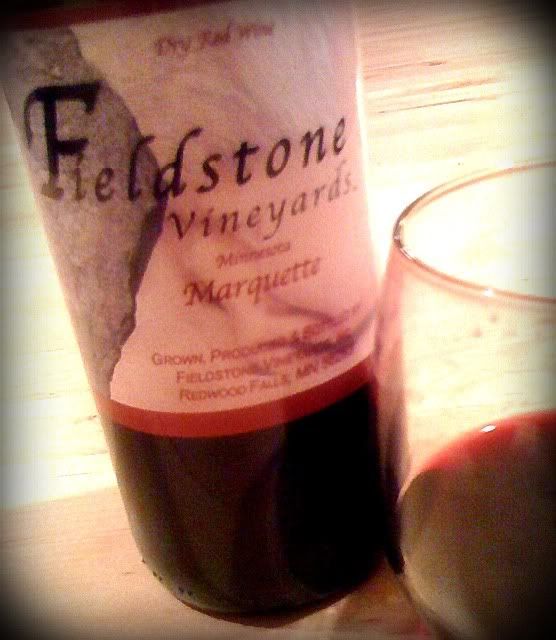 Fieldstone Vineyards in Redwood Falls, Minnesota responded to my request for an entry in this series. Thanks to owner Charles M. Quast and owner/winemaker Mark Wedge, who provided me with a bottle of their Marquette wine to sample.
Fieldstone Vineyards in Redwood Falls, Minnesota responded to my request for an entry in this series. Thanks to owner Charles M. Quast and owner/winemaker Mark Wedge, who provided me with a bottle of their Marquette wine to sample.Fieldstone is the state's largest 100% Minnesota-grown winery, and they use grapes from a network of Minnesota growers. The vineyards and winery are just two hours southwest of the Twin Cities and a couple of hours northeast of Sioux Falls, South Dakota. They utilize some of those hardy grapes like Frontenac, LaCrescent, St. Pepin and Marquette. Fieldstone was founded in 2003, at the beginning of a big growth in the state's wine industry. Their menu includes semi-sweet white wines made from LaCrescent, Frontenac, and Edelweiss and a semi-sweet Frontenac rosé. Their reds range from sweet to dry. The Marquette wine I sampled is dry.
The Fieldstone Marquette is a very dark colored wine, so dark I can hardly see through it. A grapey nose shows some herbal notes, too. The wine runs a bit hot at first, with a noticeable presence of alcohol. Decant - or just let it sit in the glass - for an hour or so, and things change dramatically. The grapiness just about goes away and a slight sense of tar joins the herbal bouquet. The tannins settle down, too, and the wine becomes silky smooth. It's very dry and a bit tart, with lots of minerality and a fair amount of acidity. After the time to open up, the Marquette's dark, sour blackberry flavor is really a delight.
If other wineries in Minnesota produce wines as interesting as the Fieldstone Vineyards Marquette, the state's small wine industry should be in for more big growth.
Follow Randy Fuller on Twitter

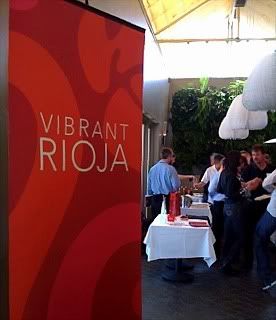



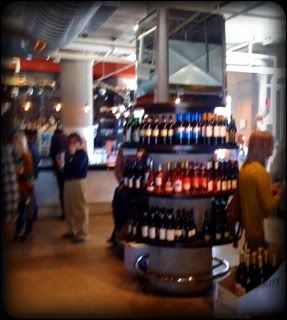

 A couple of tasty food samples were provided along with the wines. Arancini - Italian rice balls - were provided to those tasting. They paired beautifully with the Viognier, and when adorned with the duck Bolognese sauce, went well with the Sangiovese. Executive Chef Greg Stillman and Sous Chef Vincent Logan (pictured) are to be commended for turning out a large quantity at high quality. Logan told me early Saturday afternoon, "We did 800 of the Arancini, and we're running out. So Greg's in the kitchen working on another batch."
A couple of tasty food samples were provided along with the wines. Arancini - Italian rice balls - were provided to those tasting. They paired beautifully with the Viognier, and when adorned with the duck Bolognese sauce, went well with the Sangiovese. Executive Chef Greg Stillman and Sous Chef Vincent Logan (pictured) are to be commended for turning out a large quantity at high quality. Logan told me early Saturday afternoon, "We did 800 of the Arancini, and we're running out. So Greg's in the kitchen working on another batch."

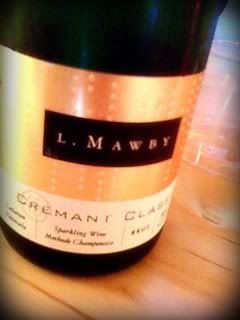 The L. Mawby Cremant Classic is made from 100% Leelanau Peninsula Vignoles from the Cremant Vineyard. It's an impressive wine, with frothy white bubbles, sweet citrus notes and almonds on the nose, lots of nuts in the flavor profile and a pleasant lemony feel on the palate. It shows a very pleasant sensation of ginger beer on the finish. The grapes used in making this wine - and the other three I'll mention - are hand-harvested and whole cluster pressed. Only the cuvée - the initial, gently pressed juice - is used in making the Cremant Classic. It retails for $22.
The L. Mawby Cremant Classic is made from 100% Leelanau Peninsula Vignoles from the Cremant Vineyard. It's an impressive wine, with frothy white bubbles, sweet citrus notes and almonds on the nose, lots of nuts in the flavor profile and a pleasant lemony feel on the palate. It shows a very pleasant sensation of ginger beer on the finish. The grapes used in making this wine - and the other three I'll mention - are hand-harvested and whole cluster pressed. Only the cuvée - the initial, gently pressed juice - is used in making the Cremant Classic. It retails for $22.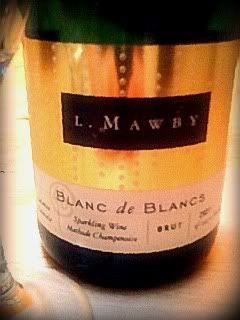 L. Mawby Blanc de Blancs - like the Cremant Classic - is also produced in the méthode champenoise. It's a non-vintage sparkler of 100% Chardonnay from the Leelanau Peninsula AVA. Only the cuvée is used and it is bottle fermented and aged a minimum of 24 months. This wine sports a nutty nose with lemon-lime citrus notes and a yeasty feel on both the nose and palate. It's bright and festive, and retails for $19.
L. Mawby Blanc de Blancs - like the Cremant Classic - is also produced in the méthode champenoise. It's a non-vintage sparkler of 100% Chardonnay from the Leelanau Peninsula AVA. Only the cuvée is used and it is bottle fermented and aged a minimum of 24 months. This wine sports a nutty nose with lemon-lime citrus notes and a yeasty feel on both the nose and palate. It's bright and festive, and retails for $19.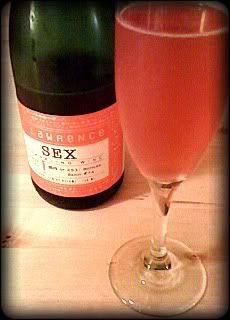 The M. Lawrence Sex is a rosé bubbly made from 75% Pinot Noir and 25% Chardonnay grapes. This one is a tad sweeter, getting a Brut dosage of 1.4% RS. Again, only the cuvée is used, but this wine is produced using cuve closefermentation - receiving its second fermentation in a closed tank.
The M. Lawrence Sex is a rosé bubbly made from 75% Pinot Noir and 25% Chardonnay grapes. This one is a tad sweeter, getting a Brut dosage of 1.4% RS. Again, only the cuvée is used, but this wine is produced using cuve closefermentation - receiving its second fermentation in a closed tank.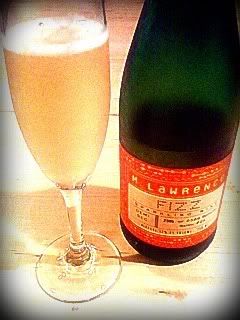 Fizz is also under the M. Lawrence label, and it's their sweetest sparkling wine. Produced from 75% Pinot Noir and 25% Chardonnay grapes, Fizz differs from the other three L. Mawby wines I tasted, in that the tailles juice is used - the second fraction of juice pressed, after cuvée - and it's finished with a Demi-Sec dosage, 3.5% RS.
Fizz is also under the M. Lawrence label, and it's their sweetest sparkling wine. Produced from 75% Pinot Noir and 25% Chardonnay grapes, Fizz differs from the other three L. Mawby wines I tasted, in that the tailles juice is used - the second fraction of juice pressed, after cuvée - and it's finished with a Demi-Sec dosage, 3.5% RS.

 The 1200 growers in Toro produce wines which have a much darker fruit expression in than those found in in Rioja. Most of the wines tasted at this seminar were between 14% and 15.5% in alcohol content. Toro has whites made from Verdejo and Malvasia. Garnacha is also employed here, but the reds are all about Tinta de Toro, and this tasting was all about the reds.
The 1200 growers in Toro produce wines which have a much darker fruit expression in than those found in in Rioja. Most of the wines tasted at this seminar were between 14% and 15.5% in alcohol content. Toro has whites made from Verdejo and Malvasia. Garnacha is also employed here, but the reds are all about Tinta de Toro, and this tasting was all about the reds. The Wines:
The Wines:


 Biltmore Reserve Chardonnay 2009 North Carolina
Biltmore Reserve Chardonnay 2009 North Carolina Biltmore Estate Château Reserve Blanc de Blancs 2008 North Carolina Méthode Champenoise Brut
Biltmore Estate Château Reserve Blanc de Blancs 2008 North Carolina Méthode Champenoise Brut


